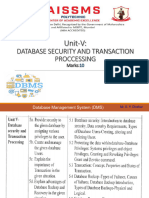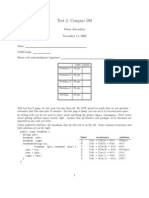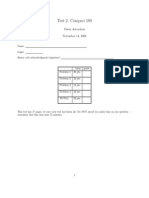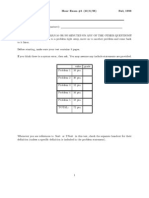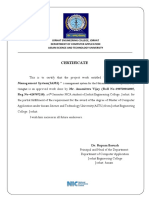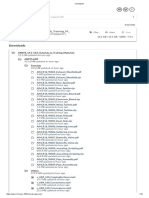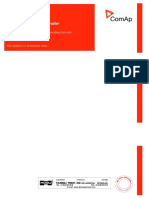Parse Tree
Parse Tree
Uploaded by
Gobara DhanCopyright:
Available Formats
Parse Tree
Parse Tree
Uploaded by
Gobara DhanOriginal Description:
Copyright
Available Formats
Share this document
Did you find this document useful?
Is this content inappropriate?
Copyright:
Available Formats
Parse Tree
Parse Tree
Uploaded by
Gobara DhanCopyright:
Available Formats
3/6/2009
1
Software Engineering II Software Engineering II
Algorithms and Data Structures Algorithms and Data Structures
Parse Trees Parse Trees
Dr. Christos Bouganis
EE2/ISE1 Algorithms & Data Structures
g
Imperial College London
1
Problem setting Problem setting
Evaluate the following expression:
X + 2*Y 7+8*Z*(X+2+Z) 4*X*Y 2*Y + K
What if K is the only variable that changes?
EE2/ISE1 Algorithms & Data Structures
3/6/2009
2
Objectives Objectives
Turn an expression into a parse tree
X + 2*Y 7
+
*
2 Y
X
7
EE2/ISE1 Algorithms & Data Structures
2 Y
The tree can be used to guide and optimize the expression
evaluation
Link to the previous lecture: The previous lecture looked
Overview Overview
at evaluating an expression while parsing it. This lecture
looks at turning an expression or sentence of a formal
language into a parse tree.
This is what most compilers do as an intermediate step
towards compiling a program.
The parse tree can then be processed or optimized. Well
see how to evaluate an expression from its parse tree.
3/6/2009
3
A parse tree is a tree structure representing sentences or
expressions of a formal language that mirrors the
grammar of that language, as defined by its BNF.
Parse Trees Parse Trees
For example, the parse tree for the expression
X + 2*Y 7
would be the following:
+
*
2 Y
X
7
<expression> ::= <term> |
<expression> + <term> |
<expression> <term>
<term> ::= <factor> |
<term> * <factor> |
<term> / <factor>
<factor> ::= <number> | ( <expression> )
<expression> ::= <term> |
<expression> + <term> |
<expression> <term>
<term> ::= <factor> |
X + 2*Y 7
Rule 1
How to construct a parse tree How to construct a parse tree
|
<term> * <factor> |
<term> / <factor>
<factor> ::= <number> | ( <expression> )
X + 2*Y 7
Rule 2
Rule 3
Rule 1
Rule 1
Rule 2
X +2*Y 7
+
X
7
2*Y
+
*
2 Y
X
7
3/6/2009
4
Declare a Parse Tree in C++ Declare a Parse Tree in C++
Lets declare the node structure of the
tree tree.
+
7
EE2/ISE1 Algorithms & Data Structures
*
2 Y
X
Heres the type declaration for a parse tree for arithmetic
expressions.
The leaves of the tree (nodes with no sub-trees) are always
numbers Other nodes comprise an operator and two
Parse Trees in C++ Parse Trees in C++
numbers. Other nodes comprise an operator and two
operands, where the operands are themselves trees.
struct TreeNode {
bool isLeaf; // true for leaf node
int number; // filled for leaf node
TreeNode* leftTree; // Pointer to left Tree
TreeNode* rightTree; // Pointer to right Tree
+
*
2 Y
X
7
g ; g
char op; // +,-,*, or /
};
typedef TreeNode* TreePtr;
3/6/2009
5
We assume that we have the access routines to handle
the expression string as in the last lecture.
We also assume the same routines to access the parse
Access Routines for Parse Trees I Access Routines for Parse Trees I
We also assume the same routines to access the parse
tree:
In addition, we have the following two access
procedures for building the parse tree and its leaves.
Access Routines for Parse Trees II Access Routines for Parse Trees II
3/6/2009
6
and
Access Routines for Parse Trees III Access Routines for Parse Trees III
sso far... o far...
Importanc
e of
parsing
trees
How to
create a
parse
Access
routines
for tree
creation
C code to
parse an
expression
C code
to parse
a term
C code
to parse
a factor
Example
p
tree
p
3/6/2009
7
The functions that turn an arithmetic expression into a
parse tree are much like the procedures in the previous
lecture for evaluating an expression.
X+Y+Z
From Expressions to Trees From Expressions to Trees
To generate the parse tree T1 for an expression E, this is
what you do.
Parse the next term in E, and let T1 be the resulting
tree.
While the next character in E is an operator (+ or ),
Read past the operator.
T1 T2
+
T2 T1
T2
+
Y X
+
Z
p p
Parse the next term in E, giving tree T2.
Let T1 be either or , depending on the
operator.
+
T1 T2
T1 T2
Heres the C++ code.
Parsing an expression Parsing an expression
3/6/2009
8
Heres the C++ code for parsing a term. No surprises here.
Parsing a Term Parsing a Term
Heres the code for parsing a factor. Again, no surprises.
Parsing a Factor Parsing a Factor
3/6/2009
9
100*(3+4) 10*(8/2)
Building a Parse Tree: An example Building a Parse Tree: An example
<expression> ::= <term> |
<expression> + <term> |
<expression> <term>
<term> ::= <factor> |
100*(3+4) - 10*(8/2)
<term> ::= <factor> |
<term> * <factor> |
<term> / <factor>
<factor> ::= <number> | ( <expression> )
So what? How can we evaluate the expression from that tree?
Here is the routine for evaluating an arithmetic expression from its
parse tree. Just traverse the tree and apply the operators in the nodes
Evaluating a Parse Tree Evaluating a Parse Tree
3/6/2009
10
Here is the routine to print the tree in console window.
void printTree(TreePtr expTree) {
if (isLeafNode(expTree))
cout << leafValue(expTree) << endl;
Printing a Tree Printing a Tree
cout leafValue(expTree) endl;
else {
printTree(leftOf(expTree));
cout << nodeOp(expTree) << endl;
printTree(rightOf(expTree));
}
}
Input: 100*(3+4)-10*(8/2)
Result: 100*3+4-10*8/2
What change should I make in order to
print the round brackets as well?
In the last two lectures we learnt to
parse an arithmetic expression
Summary Summary
evaluate an arithmetic expression (C++ code)
create a parsing tree of an arithmetic expression
evaluate the expression using a parse tree.
You might also like
- DataStage Knowledge TransferDocument4 pagesDataStage Knowledge TransferMadhu SrinivasanNo ratings yet
- Openvms History: Ruth GoldenbergDocument29 pagesOpenvms History: Ruth GoldenbergkarfijolNo ratings yet
- Install The MDA TablesDocument8 pagesInstall The MDA TablesKiwiny9999No ratings yet
- Informatica TransformationDocument86 pagesInformatica TransformationHanan AnsariNo ratings yet
- Datastage - Parameters - Schema FilesDocument23 pagesDatastage - Parameters - Schema FilesRMNo ratings yet
- Planning An Informatica Powercenter UpgradeDocument4 pagesPlanning An Informatica Powercenter Upgradespriyah_15No ratings yet
- 2 - Introduction To I Process Decision Rules EngineDocument6 pages2 - Introduction To I Process Decision Rules EngineKarthik TibcoNo ratings yet
- Chapter 11: Mass-Storage Systems: Silberschatz, Galvin and Gagne ©2018 Operating System Concepts - 10 EditionDocument49 pagesChapter 11: Mass-Storage Systems: Silberschatz, Galvin and Gagne ©2018 Operating System Concepts - 10 EditiontHe tecHniquEsNo ratings yet
- Auto CascadingPrompts Without Page Refresh in IBM CognosReport StudioDocument11 pagesAuto CascadingPrompts Without Page Refresh in IBM CognosReport StudioclrhoadesNo ratings yet
- Client/Server Software Testing: Hongmei YangDocument21 pagesClient/Server Software Testing: Hongmei YangIrfan67% (3)
- Steps To Set Up SMBC - Rte On AIX®: © 2021 IBM Corporation 1Document22 pagesSteps To Set Up SMBC - Rte On AIX®: © 2021 IBM Corporation 1Juan Carlos ParedesNo ratings yet
- AACS1304 04 - System Design 1 202005Document57 pagesAACS1304 04 - System Design 1 202005WIN YE KUANNo ratings yet
- WS Coordination: Nurhak Karakaya & Murat ÇavdarDocument25 pagesWS Coordination: Nurhak Karakaya & Murat ÇavdarAnub A NairNo ratings yet
- C++ Files and StreamsDocument31 pagesC++ Files and StreamsRiaNo ratings yet
- SQL Server To NetezzaDocument2 pagesSQL Server To NetezzaVamshi KrishnaNo ratings yet
- DBMS TM Relational Model Chapter3 (II)Document67 pagesDBMS TM Relational Model Chapter3 (II)MITMCA100% (1)
- AACS1304 05 - System Design 2 202005Document121 pagesAACS1304 05 - System Design 2 202005WIN YE KUANNo ratings yet
- Gudlavalleru Engineering College Gudlavalleru Department of Computer Science and Engineering DBMS Lab Manual For Students II B.Tech II Sem R-10Document48 pagesGudlavalleru Engineering College Gudlavalleru Department of Computer Science and Engineering DBMS Lab Manual For Students II B.Tech II Sem R-10Akshay ChavanNo ratings yet
- Relational and Logical OperatorsDocument13 pagesRelational and Logical OperatorsVamsi YvcNo ratings yet
- Infosphere Datastage Enterprise Edition InstallationDocument4 pagesInfosphere Datastage Enterprise Edition InstallationsrimkbNo ratings yet
- Object Oriented Programming in C++: Guru Nanak Dev Engg CollegeDocument32 pagesObject Oriented Programming in C++: Guru Nanak Dev Engg CollegeKumar RaviNo ratings yet
- EECS 370 Final ReviewDocument16 pagesEECS 370 Final ReviewNikki SchumakerNo ratings yet
- Datastage Enterprise Edition: Different Version of DatastageDocument5 pagesDatastage Enterprise Edition: Different Version of DatastageShailesh ChavdaNo ratings yet
- Excel Interview Questions AnswersDocument7 pagesExcel Interview Questions AnswersBirhanu Tibabu LoveNo ratings yet
- Mapxtreme V7.2.0 Release Notes: List of TopicsDocument7 pagesMapxtreme V7.2.0 Release Notes: List of TopicstruycaptudoNo ratings yet
- Microsoft Biztalk Server BasicsDocument40 pagesMicrosoft Biztalk Server Basicsk.sandeepjen100% (1)
- Unit 4 - 4.4Document23 pagesUnit 4 - 4.4King BavisiNo ratings yet
- Mail Server With Intranet and Live Chat A Java ProjectDocument19 pagesMail Server With Intranet and Live Chat A Java ProjectKartikeyan Shukla100% (1)
- Datastage ArchitectureDocument4 pagesDatastage Architecturenithinmamidala999No ratings yet
- Fetch Decode Execute Reset CycleDocument36 pagesFetch Decode Execute Reset CycleAbhishek Belnekar0% (1)
- Unit 2 (Process Synchronization) 1Document79 pagesUnit 2 (Process Synchronization) 1SseieprNo ratings yet
- Introduction of Operating Systems - Operating System Tutorial - StudytonightDocument2 pagesIntroduction of Operating Systems - Operating System Tutorial - StudytonightRashidNo ratings yet
- CA4101 Lecture 3 Business Architecture - BPMNDocument40 pagesCA4101 Lecture 3 Business Architecture - BPMNManoj VenkatNo ratings yet
- Lab Assignment Report: ECS 851 Data Warehousing and Data MiningDocument69 pagesLab Assignment Report: ECS 851 Data Warehousing and Data MiningAyush jainNo ratings yet
- M.sc. Computer ScienceDocument18 pagesM.sc. Computer SciencebeghinboseNo ratings yet
- Recognition of TokensDocument34 pagesRecognition of TokensVasantha KumariNo ratings yet
- DMS (22319) - Chapter 5 NotesDocument53 pagesDMS (22319) - Chapter 5 Notespdijgqam1n100% (1)
- TIBCO DesignerDocument19 pagesTIBCO Designeranishps2008No ratings yet
- Database and RDBMSDocument14 pagesDatabase and RDBMSAkash DeepNo ratings yet
- Overview On WCF Service ArchitectureDocument137 pagesOverview On WCF Service ArchitectureAjit KumarNo ratings yet
- DBMS Module 4 (Transactions) - 5th Semester - Computer Science and EngineeringDocument41 pagesDBMS Module 4 (Transactions) - 5th Semester - Computer Science and EngineeringReenuNo ratings yet
- Session and Data PartititioningDocument4 pagesSession and Data Partititioningyuva010No ratings yet
- Quiz2.Working With UnixDocument4 pagesQuiz2.Working With Unixcarlossg01No ratings yet
- DataStage Vs InformaticaDocument3 pagesDataStage Vs InformaticavkaturiLSNo ratings yet
- Microsoft EPSDocument3 pagesMicrosoft EPSvikas kunduNo ratings yet
- OS Lab 05Document8 pagesOS Lab 05Mohid AnwarNo ratings yet
- WCF PresentationDocument26 pagesWCF PresentationWasif AliNo ratings yet
- Algorithms Short NotesDocument7 pagesAlgorithms Short NoteskritikaNo ratings yet
- Introduction To Transaction Processing Concepts and TheoryDocument52 pagesIntroduction To Transaction Processing Concepts and TheoryRamana BadarlaNo ratings yet
- Vfront Installation Guide Win 32Document5 pagesVfront Installation Guide Win 32N WoodNo ratings yet
- DataStage Naming Standards v11 2Document17 pagesDataStage Naming Standards v11 2kottinareshNo ratings yet
- Exercises:: SolutionDocument21 pagesExercises:: Solutionhertzberg 1No ratings yet
- Microsoft SQL Server Management Studio A Complete Guide - 2021 EditionFrom EverandMicrosoft SQL Server Management Studio A Complete Guide - 2021 EditionNo ratings yet
- Test 2 Spring 01Document11 pagesTest 2 Spring 01Gobara DhanNo ratings yet
- Dr. Rodger Some Tvector FunctionsDocument18 pagesDr. Rodger Some Tvector FunctionsGobara DhanNo ratings yet
- CPS 100 J. Forbes Fall 2001 Test #2: PROBLEM 1: (Drawing (10 Points) )Document4 pagesCPS 100 J. Forbes Fall 2001 Test #2: PROBLEM 1: (Drawing (10 Points) )Gobara DhanNo ratings yet
- Function Module in SAPDocument11 pagesFunction Module in SAPGobara DhanNo ratings yet
- Test 2: CPS 100: Owen Astrachan November 15, 2000Document9 pagesTest 2: CPS 100: Owen Astrachan November 15, 2000Gobara DhanNo ratings yet
- Test 2: Compsci 100: Owen Astrachan November 11, 2009Document9 pagesTest 2: Compsci 100: Owen Astrachan November 11, 2009Gobara DhanNo ratings yet
- Owen Astrachan and Dee Ramm November 19, 1996Document11 pagesOwen Astrachan and Dee Ramm November 19, 1996Gobara DhanNo ratings yet
- Test 2: Compsci 100: Owen Astrachan November 12, 2008Document10 pagesTest 2: Compsci 100: Owen Astrachan November 12, 2008Gobara DhanNo ratings yet
- Test 2: Compsci 100: Owen Astrachan November 14, 2006Document17 pagesTest 2: Compsci 100: Owen Astrachan November 14, 2006Gobara DhanNo ratings yet
- Test 1 Spring 98Document7 pagesTest 1 Spring 98Gobara DhanNo ratings yet
- Call Adobe Form Through ABAP Web DynproDocument47 pagesCall Adobe Form Through ABAP Web DynproGobara DhanNo ratings yet
- Test 1 Spring 09Document17 pagesTest 1 Spring 09Gobara DhanNo ratings yet
- Test 1 Spring 97Document9 pagesTest 1 Spring 97Gobara DhanNo ratings yet
- Test 1 Spring 06Document11 pagesTest 1 Spring 06Gobara DhanNo ratings yet
- Test 1 Spring 95Document9 pagesTest 1 Spring 95Gobara DhanNo ratings yet
- Test 1 Spring 04Document16 pagesTest 1 Spring 04Gobara DhanNo ratings yet
- Test 1 Spring 03Document15 pagesTest 1 Spring 03Gobara DhanNo ratings yet
- CPS 100, Ramm Hour Exam #1 (10/6/98) Fall, 1998Document8 pagesCPS 100, Ramm Hour Exam #1 (10/6/98) Fall, 1998Gobara DhanNo ratings yet
- Test 1 Fall 97Document8 pagesTest 1 Fall 97Gobara DhanNo ratings yet
- Navalar CollegeDocument8 pagesNavalar CollegeHARI PRASADNo ratings yet
- Using Soap Adapter Oracle Integration PDFDocument57 pagesUsing Soap Adapter Oracle Integration PDFGisha RoyNo ratings yet
- Rexx Scripting For DB2Document4 pagesRexx Scripting For DB2scribd-itNo ratings yet
- Integrated Assets Management SystemDocument59 pagesIntegrated Assets Management SystemJavedNo ratings yet
- CloudiapadDocument19 pagesCloudiapadAns Ghazi0% (1)
- Test Complete 7Document303 pagesTest Complete 7artifex16No ratings yet
- Location, Routing, Service and UTRAN Area Planning Aspects in WCDMA (Paging)Document46 pagesLocation, Routing, Service and UTRAN Area Planning Aspects in WCDMA (Paging)Diego Andres100% (1)
- G DER ZXSDR BS8908 Product Description (V10R1) V1.00 20100708Document20 pagesG DER ZXSDR BS8908 Product Description (V10R1) V1.00 20100708Raven ZavenNo ratings yet
- ASSIGNMENTDocument5 pagesASSIGNMENTAga ChimdesaNo ratings yet
- Iot QBDocument5 pagesIot QBAdil QureshiNo ratings yet
- CS100 Computational Problem Solving Fall 2021-2022 Sarvech QadirDocument4 pagesCS100 Computational Problem Solving Fall 2021-2022 Sarvech QadirHassan WaqarNo ratings yet
- PCNSE Study GuideDocument126 pagesPCNSE Study GuideAmeet Ngangom100% (2)
- Dse4510 Mkii Dse4520 Mkii Operator ManualDocument76 pagesDse4510 Mkii Dse4520 Mkii Operator ManualMahdi DehghankarNo ratings yet
- Message Terminal TT-3606E Installation and Service Manual: Downloaded From Manuals Search EngineDocument40 pagesMessage Terminal TT-3606E Installation and Service Manual: Downloaded From Manuals Search EngineMatheus JustinoNo ratings yet
- ACTAtek 3Document62 pagesACTAtek 3linnaingeceNo ratings yet
- DV360 FormatsDocument21 pagesDV360 FormatsRicardo TapiaNo ratings yet
- PS TablesDocument8 pagesPS Tablesnarender9679No ratings yet
- REPORTING Sandvine SB Regulatory Quality MonitoringDocument2 pagesREPORTING Sandvine SB Regulatory Quality MonitoringAsif Majeed MalikNo ratings yet
- Overview of A VPN: Dial This Initial Connection, and Then Click Your Dial-Up Internet ConnectionDocument4 pagesOverview of A VPN: Dial This Initial Connection, and Then Click Your Dial-Up Internet ConnectionSwadi RajeswarNo ratings yet
- Bank Management SystemDocument29 pagesBank Management Systemarpitremarkable100% (1)
- ITN Practice Skills Assessment - PTDocument3 pagesITN Practice Skills Assessment - PTwilliamsvsNo ratings yet
- Power BI AssignmentDocument3 pagesPower BI Assignmentshikhar guptaNo ratings yet
- Visualizing Business Model Evolution With The Business Model Canvas Concept and ToolDocument8 pagesVisualizing Business Model Evolution With The Business Model Canvas Concept and Tool解思思No ratings yet
- Harsha LinuxadminDocument3 pagesHarsha Linuxadminrajesh rNo ratings yet
- Turboprint InstallDocument2 pagesTurboprint InstallStéphane GouhierNo ratings yet
- Kishore AsokanDocument1 pageKishore AsokanKishore AsokanNo ratings yet
- Chapter Four: Communication in Distributed SystemsDocument26 pagesChapter Four: Communication in Distributed Systemsbelete tilahunNo ratings yet
- 9.data Models Relational ModelDocument49 pages9.data Models Relational ModelAditya AnandNo ratings yet
- Duplicate A Database in Flash Recovery Area Using ASM To Non - Asm Using RmanDocument12 pagesDuplicate A Database in Flash Recovery Area Using ASM To Non - Asm Using RmanSHAHID FAROOQNo ratings yet
- Comp1630 RQ4Document2 pagesComp1630 RQ4malinda.wu0925No ratings yet







































